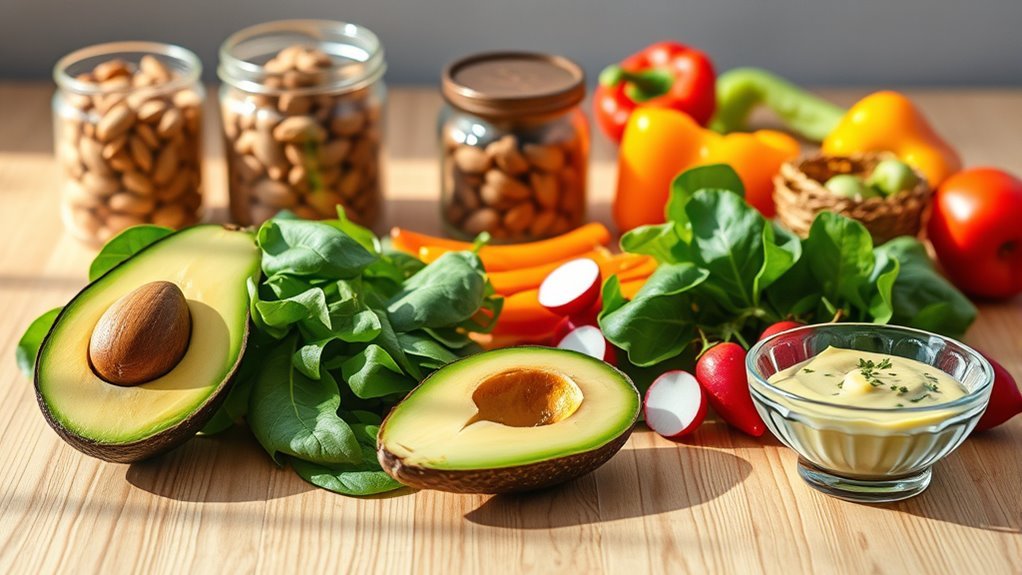In a ketogenic diet, you should aim for 20 to 50 grams of net carbohydrates daily to achieve and maintain ketosis. This range helps your body shift from burning glucose to fat for energy, promoting benefits like weight loss and improved mental clarity. It’s essential to track your carbohydrate intake to stay within these limits effectively. If you’re curious about types of carbs and practical tips for success, there’s more helpful information available.
Understanding Ketosis and Its Importance

When you understand ketosis, you reveal the key to the ketogenic diet’s effectiveness. This metabolic state occurs when your body shifts from burning glucose to burning fat for energy, leading to various ketosis benefits like weight loss, improved mental clarity, and stable energy levels. However, many people hold ketosis misconceptions, believing it’s merely a fad or that it’s inherently unhealthy. In reality, when properly managed, ketosis can enhance metabolic flexibility and promote fat oxidation. Embracing this knowledge empowers you to make informed dietary choices, allowing you to experience the freedom of sustained energy without the rollercoaster of blood sugar spikes. Understanding how ketosis works is essential for maximizing its advantages while dispelling myths that may deter you from this transformative approach.
Recommended Daily Carbohydrate Intake

To effectively achieve and maintain ketosis, it is vital to limit your daily carbohydrate intake. Generally, targeting 20-50 grams of net carbs per day is recommended, but this can vary based on individual needs and activities. Personalized nutrition plays an important role in determining the right amount for you. Some may incorporate carb cycling, adjusting their intake periodically to enhance performance while still reaping the benefits of ketosis.
| Daily Carb Intake | Description |
|---|---|
| 20-30 grams | Strict ketogenic |
| 30-50 grams | Moderate ketogenic |
| 50-100 grams | Keto-adaptive cycling |
Finding the right balance allows for flexibility while adhering to your goals. Always listen to your body and adjust as necessary.
Types of Carbohydrates: Simple vs. Complex

When considering carbohydrates in a keto diet, it is crucial to understand the difference between simple and complex carbohydrates. Simple carbohydrates, often found in sugars, can cause quick spikes in blood sugar, while complex carbohydrates provide sustained energy due to their longer digestion time. Recognizing these differences can help you make informed choices that align with your keto goals.
Simple Carbohydrates Explained
Carbohydrates are categorized into two main types: simple and complex, each playing distinct roles in nutrition. Simple carbohydrates, primarily found in sugar sources like fruits, honey, and processed sweets, consist of one or two sugar molecules. When consumed, they quickly break down into glucose, providing immediate energy. This rapid conversion can lead to spikes in blood sugar levels, impacting glucose metabolism. While simple carbs can satisfy quick hunger, relying on them excessively may disrupt energy balance and overall health. It’s important to be mindful of your intake, especially on a keto diet where carbohydrate limits are vital. Understanding these dynamics allows you to make informed choices about your sugar sources and maintain your desired lifestyle.
Complex Carbohydrates Overview
Although simple carbohydrates provide quick energy, complex carbohydrates offer a more sustained fuel source due to their structure, which consists of longer chains of sugar molecules. These complex carb sources, such as whole grains, legumes, and vegetables, break down more slowly in your body, leading to a gradual release of glucose. This slow digestion helps maintain stable blood sugar levels and can keep you feeling fuller for longer. When considering your diet, the carb quality importance cannot be overstated; choosing high-quality complex carbs over refined options can greatly impact overall health and energy levels. By focusing on nutrient-dense complex carbohydrates, you empower yourself to make informed choices that align with your health goals and lifestyle.
Impact on Keto Diet
Understanding the impact of different types of carbohydrates is essential for anyone following a ketogenic diet. Many keto misconceptions arise from confusing simple and complex carbohydrates. Simple carbs, like sugar, can spike your blood glucose levels, disrupting ketosis. In contrast, complex carbs, found in whole foods, release energy more slowly, making them a better choice if you’re looking to maintain steady energy levels.
Carb timing also plays a critical role in your diet. Consuming simple carbs post-workout can replenish glycogen stores efficiently, while complex carbs earlier in the day can sustain energy. By knowing which carbs to consume and when, you’re better equipped to achieve your keto goals, ensuring freedom in your dietary choices without compromising your health.
The Role of Fiber in a Keto Diet
Fiber plays an essential role in a ketogenic diet by supporting digestive health and maintaining regularity, which can be particularly important when carbohydrate intake is drastically reduced. Including adequate fiber sources in your meal planning can enhance your overall health. Here are some fiber benefits to take into account:
- Improved Digestive Health: Regular fiber intake helps prevent constipation.
- Satiety: Fiber-rich foods can keep you feeling full longer, aiding in weight management.
- Blood Sugar Control: Fiber can help stabilize blood sugar levels, important in a low-carb diet.
- Gut Health: Certain fibers act as prebiotics, promoting beneficial gut bacteria.
Consider fiber supplements if you struggle to meet your fiber content goals. Overall, aim to balance your fiber intake for ideal health on your keto journey.
Tracking Your Carbohydrate Intake
Tracking your carbohydrate intake is essential for successfully following a ketogenic diet, as it helps guarantee you remain within your targeted carb limit. By engaging in carb counting, you can maintain the state of ketosis that fuels fat burning. Utilizing various tracking tools, such as apps or spreadsheets, allows you to log your daily food intake accurately. These tools often provide nutrient breakdowns, making it easier to identify high-carb foods that may disrupt your progress. Consistently monitoring your carb consumption not only enhances your awareness of what you’re eating but also empowers you to make informed choices. Remember, staying within your limits is key to enjoying the freedom and benefits of a ketogenic lifestyle without derailing your efforts.
Hidden Carbs: What to Watch Out For
Even with careful tracking, hidden carbs can sneak into your diet and disrupt your ketogenic goals. To stay on track, you’ll want to be vigilant about certain sources of hidden ingredients. Here are some areas to examine:
Hidden carbs can disrupt your ketogenic goals; be vigilant with packaged products, condiments, snacks, and restaurant choices.
- Packaged Products: Always check food labels for added sugars and starches.
- Condiments: Many sauces and dressings contain unexpected carbs; opt for low-carb alternatives.
- Surprising Snacks: Items like protein bars and flavored nuts can have hidden sugars; read the labels.
- Restaurant Choices: Be cautious with seemingly keto-friendly options; sauces and marinades can contain hidden carbs.
Adjusting Carb Intake for Individual Needs
When adjusting your carb intake on a keto diet, it’s vital to take into account your personal metabolic rate, as this impacts how your body processes carbohydrates. Additionally, your activity level plays an important role in determining the amount of carbs you can include while still meeting your health goals. Tailoring your carb consumption to these factors can enhance your overall success on the ketogenic diet.
Personal Metabolic Rates
Understanding your personal metabolic rate is essential for effectively adjusting your carbohydrate intake on a ketogenic diet. Individual variations in personal metabolism lead to metabolic differences that can greatly impact your results. Here are four key factors to take into account:
- Basal Metabolic Rate (BMR): Your body’s energy expenditure at rest.
- Age: Metabolism typically slows with age, influencing carb needs.
- Sex: Males generally have a higher BMR than females, affecting carb intake.
- Body Composition: Muscle mass increases your metabolic rate, allowing for more carbs.
Activity Level Considerations
Your activity level plays a significant role in determining how many carbohydrates you should include in your ketogenic diet. If you lead a sedentary lifestyle, your body may require fewer carbs, as it relies more on fat for energy. Conversely, if you engage in regular exercise, particularly high-intensity workouts, your daily routines might demand additional carbohydrates to support performance and recovery. Understanding the exercise impact on your body helps tailor your carb intake to your needs. Lifestyle variations, such as job demands or recreational activities, also influence your energy requirements. By evaluating your activity level, you can adjust your carb consumption, ensuring you maintain the freedom to enjoy a balanced, effective ketogenic diet that suits your unique lifestyle.
Health Goals Alignment
Aligning your carbohydrate intake with your health goals is essential for maximizing the benefits of a ketogenic diet. By customizing your carb consumption, you can better support your unique objectives. Here are key steps for effective health goals alignment:
- Define Your Goals: Set clear, achievable goals, whether it’s weight loss, improved energy, or enhanced mental clarity.
- Assess Your Needs: Consider your activity level, metabolic rate, and dietary preferences to determine your ideal carb range.
- Track Your Progress: Regularly monitor your results; adjust your intake based on how your body responds.
- Stay Flexible: Be prepared to tweak your carb levels as your goals evolve or as you encounter plateaus.
This tailored approach empowers you to navigate your keto journey with confidence and freedom.
Low-Carb Foods to Include in Your Diet
When starting on a ketogenic diet, incorporating low-carb foods is essential for maintaining ketosis and optimizing health. Focus on fresh vegetables, healthy fats, and protein sources. You’ll find that planning your meals and snacks ahead can streamline your keto meal prepping and keep you on track.
Here’s a quick reference table of excellent low-carb foods:
| Protein Sources | Healthy Fats | Low Carb Snacks |
|---|---|---|
| Chicken | Avocado | Cheese sticks |
| Salmon | Olive oil | Nuts (almonds) |
| Eggs | Coconut oil | Celery with cream cheese |
| Tofu | Butter | Pork rinds |
Incorporating these options not only supports your dietary goals but also provides delicious variety in your meals.
Common Mistakes to Avoid on Keto
Maintaining a ketogenic diet can be challenging, and many individuals encounter common pitfalls that hinder their progress. To optimize your keto meal planning and enhance your results, avoid these mistakes:
Maintaining a ketogenic diet requires vigilance; avoid common pitfalls to enhance your meal planning and progress.
- Neglecting Macros: Failing to track your macronutrient intake can lead to excessive carb consumption.
- Underestimating Portions: Portion control is essential; overeating healthy fats can stall your progress.
- Ignoring Hidden Carbs: Processed foods and sauces often contain hidden sugars that can disrupt ketosis.
- Not Staying Hydrated: Dehydration can lead to fatigue and cravings, impacting your ability to adhere to the diet.
Delicious Keto-Friendly Recipes to Try
Exploring a variety of delicious keto-friendly recipes can make your dietary journey both enjoyable and sustainable. By incorporating keto meal prep and flavorful seasonings, you can create satisfying dishes that fit your low-carb lifestyle. Here are some recipe ideas to inspire you:
| Recipe | Key Ingredients |
|---|---|
| Cauliflower Pizza | Cauliflower, cheese |
| Zucchini Noodles | Zucchini, pesto |
| Keto Chili | Ground beef, tomatoes |
| Egg Muffins | Eggs, spinach, cheese |
Each recipe can be customized to suit your taste preferences, making them versatile options for any meal. With these options, you won’t feel deprived while enjoying the freedom of a keto diet. Happy cooking!


